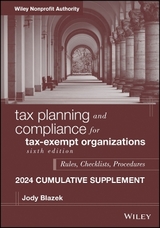
Tax Planning and Compliance for Tax-Exempt Organizations, 2023 Cumulative Supplement
John Wiley & Sons Inc (Verlag)
978-1-394-17976-3 (ISBN)
- Titel erscheint in neuer Auflage
- Artikel merken
This book is an indispensable guide to navigating the complex maze of nonprofit tax rules and regulations. A clear and fully cited description of the requirements for the various categories of tax-exempt entities from public charities, private foundations, civic associations, business leagues, and social clubs to title-holding companies and governmental entities can be found. Practical guidance on potential for income tax on revenue-producing enterprises along with explanations of many exceptions to taxability is provided. Issues raised by Internet activity, advertising, publishing, providing services, and much more are explained.
This useful annual supplement for 2023 will cover any and all changes and updates to the law within the previous 12 month period and will keep accountants, attorneys, and others up-to-date for the year ahead.
Features a variety of sample documents for private foundations, including penalty abatement requests and sharing space agreements
Provides helpful practice aids, such as a comparison of the differences between public and private charities, charts reflecting lobbying limits for different types of entities, and listings of rulings and cases that illustrate permissible activity for each type of organizations compared to impermissible activity
Preface ix
Part I Qualifications of Tax-Exempt Organizations 1
Chapter 1 Distinguishing Characteristics of Tax-Exempt Organizations 3
§ 1.4 Role of the Internal Revenue Service 8
§ 1.8 Developments Responding to COVID-19 11
Chapter 2 Qualifying Under IRC § 501(c)(3) 19
§ 2.2 Operational Test 19
Chapter 3 Religious Organizations 29
§ 3.2 Churches 29
Chapter 4 Charitable Organizations 37
§ 4.1 Relief of the Poor 37
§ 4.3 Lessening the Burdens of Government 39
§ 4.5 Advancement of Education and Science 39
§ 4.6 Promotion of Health 42
Chapter 5 Educational, Scientific, and Literary Purposes and Prevention of Cruelty to Children and Animals 43
§ 5.1 Educational Purposes 43
Chapter 6 Civic Leagues and Local Associations of Employees: § 501(c)(4) 45
§ 6.2 Qualifying and Nonqualifying Civic Organizations 45
§ 6.4 Neighborhood and Homeowner’s Associations 48
Chapter 9 Social Clubs: § 501(c)(7) 49
§ 9.1 Organizational Requirements and Characteristics 49
§ 9.4 Revenue Tests 50
Chapter 10 Instrumentalities of Government and Title-Holding Corporations 53
§ 10.6 Requirements for IRC § 501(c)(8) and § (c)(10) 53
Chapter 11 Public Charities 63
§ 11.2 “Inherently Public Activity” and Broad Public Support: § 509(a)(1) 63
§ 11.5 Difference Between § 509(a)(1) and § 509(a)(2) 64
§ 11.9 Supporting Organization: § 509(a)(3) 64
Part II Standards For Private Foundations 65
Chapter 12 Private Foundations—General Concepts 67
§ 12.4 Termination of Private Foundation Status 67
Chapter 13 Excise Tax Based on Investment Income: IRC § 4940 69
§ 13.2 Capital Gains 69
Chapter 14 Self-Dealing: IRC § 4941 71
§ 14.2 Sale, Exchange, or Lease of Property 71
§ 14.5 Transactions That Benefit Disqualified Persons 71
Chapter 15 Minimum Distribution Requirements: IRC § 4942 75
§ 15.1 Assets Used to Calculate Minimum Investment Return 75
§ 15.2 Measuring Fair Market Value 75
§ 15.4 Qualifying Distributions 78
Chapter 16 Excess Business Holdings and Jeopardizing Investments: IRC §§ 4943 and 4944 83
§ 16.1 Excess Business Holdings 83
§ 16.2 Jeopardizing Investments 84
Chapter 17 Taxable Expenditures: IRC § 4945 89
§ 17.1 Lobbying 89
§ 17.3 Grants to Individuals 89
§ 17.4 Grants to Public Charities 95
Part III Obtaining and Maintaining Tax-Exempt Status 97
Chapter 18 IRS Filings, Procedures, and Policies 99
§ 18.1 IRS Determination Process 102
§ 18.2 Annual Filing of Forms 990 112
§ 18.3 Reporting Organizational Changes to the IRS 130
§ 18.4 Weathering an IRS Examination 130
Chapter 19 Maintaining Exempt Status 137
§ 19.1 Checklists 137
Chapter 20 Private Inurement and Intermediate Sanctions 145
§ 20.2 Salaries and Other Compensation 145
§ 20.10 Intermediate Sanctions 146
§ 20.11 New § 4960 Excise Tax on Excess Compensation 156
Chapter 21 Unrelated Business Income 161
§ 21.4 Definition of Trade or Business 167
§ 21.8 Unrelated Activities 168
§ 21.10 Income Modifications 168
§ 21.11 Calculating and Minimizing Taxable Income 169
Chapter 23 Electioneering and Lobbying 175
§ 23.1 Election Campaign Involvement 175
§ 23.3 Tax on Political Expenditures 176
Chapter 24 Deductibility and Disclosures 179
§ 24.1 Overview of Deductibility 179
§ 24.2 The Substantiation and Quid Pro Quo Rules 183
§ 24.3 Valuing Donor Benefits 186
Chapter 25 Employment Taxes 187
§ 25.1 Distinctions Between Employees and Independent Contractors 187
§ 25.2 Ministers 191
§ 25.3 Reporting Requirements 192
Chapter 27 Cryptocurrency 195
§ 27.1 What Is Cryptocurrency? 195
§ 27.2 What Are the Various Kinds of Cryptocurrency? 195
§ 27.3 Should Nonprofits Be Involved in Cryptocurrency? 197
§ 27.4 Cryptocurrencies and the Internal Revenue Service 199
Index 211
| Erscheinungsdatum | 23.08.2023 |
|---|---|
| Verlagsort | New York |
| Sprache | englisch |
| Maße | 178 x 252 mm |
| Gewicht | 363 g |
| Themenwelt | Wirtschaft ► Betriebswirtschaft / Management |
| ISBN-10 | 1-394-17976-6 / 1394179766 |
| ISBN-13 | 978-1-394-17976-3 / 9781394179763 |
| Zustand | Neuware |
| Haben Sie eine Frage zum Produkt? |
aus dem Bereich



